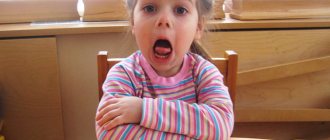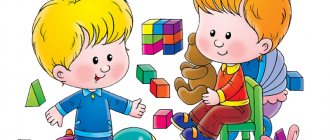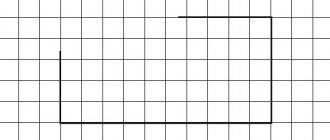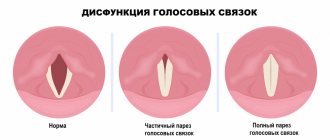Development of coherent speech in ontogenesisarticle on speech therapy on the topic
Development of coherent speech in ontogenesis
Coherent speech is inseparable from the world of thoughts: coherence of speech is coherence of thoughts. Coherent speech reflects the logic of the child’s thinking, his ability to comprehend what he perceives and express it in correct, clear, logical speech.
Coherent speech, emphasized F.A. Sokhin, is not just a sequence of interconnected thoughts that are expressed in precise words in correctly constructed sentences. Coherent speech, as it were, absorbs all the child’s achievements in mastering his native language, in mastering its sound side, vocabulary and grammatical structure. By the way children construct their statements, one can judge the level of their speech development. The ability to talk helps a child to be sociable, overcome silence and shyness, and develop self-confidence.
Speech is not an innate ability, but develops in the process of ontogenesis in parallel with the physical and mental development of the child and serves as an indicator of his overall development. A child’s acquisition of his native language follows a strict pattern and is characterized by a number of features common to all children. In order to understand speech pathology, it is necessary to clearly understand the entire path of sequential speech development of children in normal conditions, to know the patterns of this process and the conditions on which its successful occurrence depends.
Researchers identify a different number of stages in the development of children’s speech, call them differently, and indicate different age limits for each. A. N. Leontyev established four stages in the development of speech in children:
1st – preparatory – up to one year;
2nd – pre-preschool stage of initial language acquisition – up to 3 years;
3rd – preschool – up to 7 years;
· 4th – school – from 7 to 17 years.
In order for the process of speech development in children to proceed in a timely and correct manner, certain conditions are necessary. The child must:
- be mentally and somatically healthy;
- have normal mental abilities;
- have normal hearing and vision;
- have sufficient mental activity;
- have a need for verbal communication;
- have a full-fledged speech environment.
The first stage is preparatory (from the moment the child is born to one year).
At this time, preparation for mastering speech occurs. From the moment of birth, the child develops vocal reactions: screaming and crying. True, they are still very far from the sounds of human speech. However, both screaming and crying contribute to the development of subtle and varied movements of the three sections of the speech apparatus: respiratory, vocal, articulatory.
After two weeks, the child begins to respond to the speaker’s voice - he stops crying and listens when he is addressed. By the end of the first month, he can already be calmed down with a melodic song (lullaby). Next, he begins to turn his head towards the speaker or follow him with his eyes. Soon the baby already reacts to intonation: to a gentle one he becomes animated, to a harsh one he cries.
Around 2 months, humming appears and by the beginning of the 3rd month, babbling appears - a combination of vaguely articulated sounds. From the age of 5 months, the child hears sounds, sees articulatory movements of the lips of others and tries to imitate. Repeated repetition of a specific movement leads to consolidation of a motor skill.
From the age of 6 months, the child pronounces individual syllables by imitation (ma-ma-ma, ba-ba-ba, cha-cha-cha, pa-pa-pa, etc.).
Through imitation, the child gradually adopts all the elements of spoken speech: not only phonemes, but also tone, tempo, rhythm, melody and intonation.
In the second half of the year, the child perceives certain sound combinations and associates them with objects or actions (tick-tock, give-dim, bang). But at this time he still reacts to the entire complex of influences: the situation, intonation and words. All this helps the formation of temporary connections (memorizing words and reacting to them).
At the age of 7-9 months, the child begins to repeat more and more diverse combinations of sounds after the adult.
From 10 to 11 months, reactions to the words themselves appear (regardless of the situation and intonation of the speaker).
At this time, the conditions in which the child’s speech is formed (correct speech of others, imitation of adults, etc.) become especially important.
By the end of the first year of life, the first words appear.
The second stage is pre-preschool (from one year to 3 years). With the appearance of the child’s first words, the preparatory stage ends and the stage of development of active speech begins. At this time, the child develops special attention to the articulation of those around him. He very much and willingly repeats after the speaker and pronounces the words himself. At the same time, the child confuses sounds, rearranges them, distorts them, and omits them.
The child’s first words are of a generalized semantic nature. With the same word or sound combination it can denote an object, a request, or feelings. The child accompanies situational speech with gestures and facial expressions.
From the age of one and a half years, the word acquires a generalized character. It becomes possible to understand an adult’s verbal explanation, assimilate knowledge, and accumulate new words.
During the 2nd and 3rd years of life, a child experiences a significant accumulation of vocabulary.
Children's vocabulary by 1 year 6 months is 10-15 words, by the end of the 2nd year - 300 words, by 3 years - about 1000 words.
The meanings of words become more and more defined. By the beginning of the 3rd year of life, the child’s grammatical structure of speech begins to form. Gradually, elements of coordination and subordination of words in a sentence appear.
By the age of 2, children practically master the skills of using singular and plural forms of nouns, tense and person of verbs, and use some case endings. At this time, understanding an adult’s speech significantly exceeds pronunciation capabilities.
The third stage is preschool (from 3 to 7 years). At the preschool stage, most children still have incorrect sound pronunciation. You can detect defects in the pronunciation of whistling, hissing, sonorant sounds, and less often - defects in softening, voicing and iotation.
Over the period from 3 to 7 years, the child increasingly develops the skill of auditory control over his own pronunciation, the ability to correct it in some possible cases. In other words, phonemic perception is formed.
During this period, the rapid increase in vocabulary continues. By the age of 4-6 years, a child’s active vocabulary reaches 3000-4000 words. The meanings of words are further clarified and enriched in many ways.
In parallel with the development of vocabulary, the development of the grammatical structure of speech also occurs. During the preschool period, children master coherent speech. Children of the 4th year of life use simple and complex sentences in speech. By the age of 4, a child should normally differentiate all sounds, i.e. he must have developed phonemic perception. By this time, the formation of correct sound pronunciation ends and the child speaks completely clearly.
In children of senior preschool age, the development of coherent speech reaches a fairly high level.
By the age of 5, children are relatively fluent in using the structure of compound and complex sentences. Starting at this age, children's statements resemble a short story. During conversations, their answers to questions include more and more sentences.
At the age of five, children, without additional questions, compose a retelling of a fairy tale (story) of 40-50 sentences, which indicates success in mastering one of the difficult types of speech - monologue speech.
During this period, phonemic perception significantly improves: first, the child begins to differentiate vowels and consonants, then soft and hard consonants, and, finally, sonorant, hissing and whistling sounds.[16]
Throughout the preschool period, contextual speech is gradually formed. Contextual speech appears first when the child retells fairy tales and stories, then when describing some events from his personal experience, his own experiences, impressions.
So, by the time they enter school, coherent speech in children with normal speech development is quite well developed.
The fourth stage is school (from 7 to 17 years). The main feature of speech development in children at this stage compared to the previous one is its conscious assimilation. Children master sound analysis and learn grammatical rules for constructing statements.
The leading role here belongs to a new type of speech—written speech.
At school age, a purposeful restructuring of the child’s speech occurs - from the perception and discrimination of sounds to the conscious use of all linguistic means.
Of course, these stages cannot have strict, clear boundaries. Each of them smoothly transitions into the next.
So, normal (timely and correct) speech development of a child allows him to constantly acquire new concepts, expand his stock of knowledge and ideas about the environment. Thus, speech and its development are most closely related to the development of thinking.
Patterns of normal speech development according to A. N. Gvozdev
The proposed scheme is based on the peculiarities of the appearance of parts of speech and grammatical categories in children. A. N. Gvozdev distinguishes two stages:
- use of amorphous words;
- mastery of grammatical categories.
When constructing correctional work, speech therapists rely on these patterns of ontogenetic speech development.
Amorphous root words
A. N. Gvozdev begins to consider the acquisition of the native language system from one year and 8 months, when the baby already has his first words. This stage is divided into two sub-periods, each of which has its own characteristics.
- One-word - the baby uses only individual words that act as sentences. Some of them serve to express his desires and feelings. At this time, he actively uses facial expressions and gestures. The first words do not have a clear grammatical form: he uses them in one sound image in different contexts (“bi” - car, driving, etc.).
Most of them are nouns, onomatopoeic complexes and babble. In total, the child’s dictionary during this period contains about 29 such amorphous words. He clearly pronounces vowels, labiolabials, front-lingual, back-lingual, Сь, Ль. The syllabic structure consists of one stressed syllable or two identical ones.
- The second sub-period is characterized by combining words into one phrase, but it is ungrammatical. Indeclinable nouns and verbs appear in the form of the imperative mood (“drink”, “give”, etc.). The syllable structure becomes more complex: the baby learns the pronunciation of two-syllable words. Хь, Ц, И appears, sometimes he may omit a sound at the beginning or end of a word. The baby also masters the pronunciation of consonant clusters that appear in the middle of some words.
During this age period, the prerequisites for the child’s successful mastery of the components of the language system are formed. He begins to use the simplest forms of parts of speech and sounds with simple articulation patterns.
Mastering the grammatical structure of sentences
This long period begins at 1 year 8 months. and lasts up to 6 years. The child masters all grammatical skills; The syllable structure and sound pronunciation are fully formed by the age of 5-6 years. Children are actively engaged in word creation. This phenomenon is caused by attempts to master the norms of the native language without knowing the grammatical rules.
First period
First forms of words (1 year 8 months – 2 years). The baby combines 3-4 words into a sentence. He masters the skill of agreeing a noun in the nominative case with a verb, and the initial signs of adjective subordination appear. Phrase speech itself is characterized by ungrammaticality.
Begins to decline words according to cases (nominative, accusative, prepositional); adds diminutive suffixes; new inflections of verbs appear; often omits prefixes.
During this period, the first adjectives appear, but the child uses them without agreement with the noun. Adverbs and pronouns appear (he speaks about himself in the 3rd person); particles. In three-syllable words the child omits the pre-stressed syllable, but in four-syllable words the syllable structure is most often preserved.
Articulatory structures N, T, D appear. Most of the consonant clusters are replaced by a single phoneme.
Second period
From 2 years to 2 years 6 months. endings are learned and conjunctions are added to sentences. A common mistake is replacing endings and using them within the same meaning. Suffixes, dative and instrumental cases appear. Begins to inflect verbs according to persons and tenses, but can mix gender.
The number of adjectives increases, but when using them, the child violates the norms of agreement. The plural form is used only in the nominative case. Personal pronouns are being learned; adverbs that are used for comparison. More prepositions and complex conjunctions appear.
In complex words, omission of pre-stressed syllables and prefixes is most common. The child often mixes similar phonemes in speech. The sequence of consonants remains unlearned, but he pronounces some groups correctly.
Third period
From 2.6 months By the age of 3 years, the child masters the functional parts of speech. The structure of the sentence becomes more complex, and the skill of subordinating words appears. But the child has not yet mastered the category of gender. Almost all the main case endings have been mastered, but the influence of O is more common in them. Suffixes denoting increase are being mastered.
The child freely uses all forms of reflexive verbs and prefixes. But sometimes he can mix them up. Begins to use coordination skills when constructing sentences. Forms of short participles appear. The child confuses possessive pronouns. Uses prepositions and most conjunctions correctly.
Distortion of syllable structure is rare, most often in unfamiliar words. Articulatory patterns of hissing sounds are formed; the pronunciation of consonant sequences is learned.
The fourth period
At 3-4 years old, agrammatic sentences become less and less common in children’s speech. The child is actively engaged in word creation. The ending -OV continues to influence the declination. Difficulties arise in agreeing neuter adjectives. The comparative degree of adjectives and adverbs, the particle BY, appears. The pronunciation side is fully formed.
Fifth period
The period from 4 to 6 years is characterized by the acquisition of almost all grammatical forms of parts of speech. The child has difficulty making sentences with the word “which”.
The boundaries of all the listed stages are approximate; everything depends on the individual characteristics of the child, on the conditions of the speech environment in which he grows. Thanks to knowledge of the stages of ontogenetic development of speech, it is possible to determine how the process of assimilation of language components proceeds. Taking into account ontogenetic and mental characteristics, speech therapists carry out correctional work.






